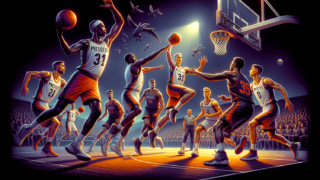
How to Be a Better Communicator on the Basketball Court?
Written by: Basketball Universe
Last updated:

Bouncing a basketball on the hardwood floor is only half the battle to dominating the game; communication is where you truly excel. In this blog post, we’ll explore how to become a better communicator on the basketball court, taking you one step closer to becoming an indispensable asset to your team. Whether you’re shooting hoops with friends or you’re aiming to strengthen your team’s chemistry ahead of the next championship game, effective communication can make or break your performance. So lace-up your sneakers, grab a bottle of your favorite sports drink, and let’s dive into the art of chatter on the court!
How to Be a Better Communicator on the Basketball Court?
To be a better communicator on the basketball court, focus on active listening, clear verbal and non-verbal cues, appropriate body language, and adapting to varied team dynamics. Master these communication methods to effectively convey your intentions, encourage team synergy, and avoid misunderstandings during gameplay. By honing these skills, you’ll enhance your team’s performance and create a more cohesive, collaborative atmosphere on the court.
Master Active Listening Skills
Becoming an effective communicator on the basketball court starts with mastering the art of active listening. To listen actively, immerse yourself in what your teammates and coach are saying, acknowledge their input, and respond appropriately. This approach not only demonstrates respect but also ensures that you accurately interpret the sender’s message, allowing you to make better decisions during the game. Here’s how to exercise active listening while playing basketball:
Focus and Eliminate Distractions
Concentrate on the person speaking to you, whether it’s your teammate or your coach. Be mentally present and eliminate distractions such as crowd noise and your own thoughts. This enables you to receive important messages like instructions, feedback, or strategic adjustments during gameplay.
Provide Feedback
Show that you’ve heard and understood the speaker by nodding, maintaining eye contact, and using verbal confirmations like ‘okay,’ ‘got it,’ or ‘I understand.’ Feedback helps create mutual understanding and facilitates the exchange of valuable information on the court.
Use Verbal and Non-Verbal Communication
Effective court communication involves a combination of verbal and non-verbal cues. Harness the power of both to relay vital information, coordinate plays, and maintain team chemistry. Here’s what you need to know:
Verbal Communication
Be concise and precise with your words when communicating verbally. Your message should be clear and easy to understand, even amidst the sounds of a bustling basketball game. Here are a few tips:
- Call out plays, positions, and defensive adjustments using agreed terminology.
- Project your voice to ensure teammates can hear you.
- Keep messages brief and concise to avoid miscommunication.
- Speak respectfully and positively to foster a supportive team environment.
Non-Verbal Communication
Don’t underestimate the importance of non-verbal cues on the basketball court. Your body language and gestures can provide valuable information during a game. Consider the following when using non-verbal communication:
- Use identifiable hand signals to communicate plays, strategies, or adjustments.
- Display positive body language by maintaining an upright posture and composed facial expressions, even when the game gets heated.
- Avoid displaying frustration or anger on the court, as that can affect team morale and performance.
- Develop a system of unique signals with teammates to establish discreet communication during competitive matches.
Embrace the Power of Body Language
Body language is an essential element of court communication. Demonstrating the right body language can convey your message effectively, express your emotions, and even influence your teammates’ attitudes. Use these tips to send the right signals to your teammates:
Maintain a Confident Posture
A confident posture not only communicates self-assurance to your teammates but also raises your personal energy levels. Stand tall, keep your head up, and maintain a relaxed, open stance to exude confidence and readiness for action.
Be Aware of Facial Expressions
Your facial expressions can impact your team’s morale, making it essential to choose them wisely. Smiling, for instance, shows that you’re enjoying the game and can help keep the atmosphere positive despite tough situations. By contrast, a frustrated, angry expression may dishearten your teammates and hinder performance.
Control Gestures and Movements
Hand gestures and movements are critical to basketball communication. Ensure that your gestures are visible, appropriate, and universally understood by teammates. Practice using gestures to execute plays, call out defensive assignments, or request a pass without verbal cues.
Adapt to Varying Team Dynamics
Every basketball team has unique dynamics, and learning to adapt to them significantly improves on-court communication. Familiarize yourself with the communication styles, preferences, and strengths of your teammates and your coach. Consider these strategies to enhance your adaptability:
Observe and Learn
Pay attention to your teammates’ and coach’s communication preferences. Observe their preferred ways of handling feedback, criticism, or praise, and adjust your approach accordingly to maximize effectiveness.
Mirror Communication Styles
To improve rapport and enhance understanding, try mirroring the communication styles of your teammates and coach. For instance, if a teammate prefers hand signals to verbal cues during intense moments, adopt the same approach when communicating with them.
Be Empathetic
Develop empathy by considering your teammates’ perspectives, feelings, and experiences. This understanding enables you to anticipate their communication needs and preferences, leading to smoother interactions and improved team chemistry.
Practice Pre-Game and Post-Game Communication
Effective basketball court communication is not confined to game time. Utilizing pre-game and post-game discussions can create strong team connections, build trust, and catapult your on-court communication to new heights. Here’s how:
Pre-Game Communication
Before the game begins, engage in team discussions that set expectations, establish goals, and clarify roles. Use this time to:
- Reinforce game strategies and plays.
- Encourage and motivate one another.
- Review opponents’ strengths and weaknesses.
- Reiterate the importance of effective communication during the game.
Post-Game Communication
After the final buzzer, gather your team to review the game. This debriefing helps identify areas of improvement, celebrate achievements, and strengthen team bonds. Focus on:
- Analyzing key moments that influenced the game’s outcome.
- Providing constructive feedback and discussing potential adjustments for future matches.
- Recognizing and praising individual and team accomplishments.
- Encouraging open, honest communication of thoughts and feelings about the game.
Celebrate Effective Communication in Basketball
Emphasizing the value of effective communication on the basketball court sets the stage for success. By mastering active listening, using verbal and non-verbal cues, embracing the power of body language, adapting to team dynamics, and participating in pre-game and post-game discussions, you can elevate your team’s performance and pave the way to victory. Invest in these communication skills to take your game to new heights and leave your mark on the basketball court.
Develop Team Chemistry Off the Court
Team chemistry is crucial for effective communication on the basketball court. Building strong relationships off the court can translate into better understanding and trust during games. Encourage team bonding activities like the following:
Organize Team Building Activities
Plan activities that enable teammates to interact, cooperate, and have fun together. These events can include group dinners, attending sports events, or engaging in team-building exercises such as escape rooms or trust-building games.
Establish Open Communication Channels
Create an environment where everyone feels comfortable providing feedback, sharing thoughts, and discussing strategies. Establish open communication channels like group chats, online forums, or regular group meetings, allowing your team to stay connected and engaged outside the court.
Continuously Develop Communication Skills
Consistently honing your communication skills is key to becoming a better communicator on the basketball court. Here are some ideas to consider for continuous improvement:
Attend Communication Workshops
Explore opportunities to attend workshops, seminars, or courses focused on effective communication. These events can provide valuable insights and tools for improving your ability to convey messages in high-pressure, fast-paced environments like basketball games.
Practice Active Listening Daily
Incorporate active listening into your everyday life by practicing it in conversations with friends, family, or colleagues. This habit will eventually translate into better listening skills on the basketball court, helping you become a more effective communicator.
Seek Feedback and Mentorship
Ask your coach, teammates, or mentors for advice on how to enhance your communication skills. Open yourself up to constructive criticism and commit to implementing suggested improvements both on and off the court.
Highlight the Importance of Communication in Youth Basketball
Transforming youth basketball players into effective communicators is vital for their long-term success in the sport. Coaches and parents play a crucial role in instilling the value of communication early on. Here’s what you can do:
Teach Active Listening Skills
Introduce the concept of active listening to young players and explain its importance in basketball. Encourage young athletes to practice these skills in games and daily life, setting the foundation for improved court communication as they progress in their basketball journey.
Establish Consistent Terminology and Signals
Introduce youth players to common basketball terminology and hand signals that are universally recognized. As they become familiar with this system, they will be better equipped to communicate seamlessly with their teammates and coaches in future games.
Promote a Positive Team Environment
Developing an environment that values open, honest, and positive communication can have a lasting impact on a player’s approach to communication in the sport. Encourage youth teams to adopt these values from the get-go to foster team chemistry, trust, and support.
In summary, effective communication is critical for success on the basketball court. By working on your active listening, verbal and non-verbal communication, body language, adaptability, and pre-game and post-game discussions, you can become a better communicator and elevate your team’s performance. Don’t forget to develop team chemistry off the court, continuously improve communication skills, and emphasize the importance of communication in youth basketball to set the stage for long-term success in the sport.
FAQs on Basketball Court Communication
If you’re looking to improve your communication skills on the basketball court, you might have some questions. Here’s a list of frequently asked questions and their answers to help you better understand and apply the concepts discussed in this blog post:
Why is communication important in basketball?
Communication is essential in basketball because it enables players to work together effectively, maintain team chemistry, execute plays, make strategic adjustments, and minimize misunderstandings during the game. Effective communication drives better team performance and increases the likelihood of success.
How can I improve my listening skills in basketball?
To improve your listening skills in basketball, practice active listening. Focus on the person speaking, eliminate distractions, provide feedback, and apply what you’ve heard on the court. Practicing active listening in everyday conversations can also help strengthen your skills in basketball contexts.
What are some common verbal cues used in basketball?
Common verbal cues in basketball include calling out plays, positions, defensive adjustments, and opponent weaknesses. Using agreed-upon terminology ensures messages are clear and easy to understand among teammates. Always communicate respectfully and positively to maintain a supportive team environment.
What kind of non-verbal cues are important in basketball?
Non-verbal cues, such as hand signals, body language, and facial expressions, are crucial in basketball for conveying plays, strategies, adjustments, and emotions without using words. Develop visible, appropriate, and universally understood gestures, and ensure that your body language remains positive and composed.
How can I read my teammates’ body language during a game?
To read your teammates’ body language, observe their posture, facial expressions, gestures, and movements. Look for signs of confidence, frustration, or fatigue, and use this information to adapt your communication or gameplay accordingly. Developing strong team chemistry can further enhance your ability to read and interpret your teammates’ body language.
How can I avoid misunderstandings when communicating on the court?
To avoid misunderstandings, be clear and concise with your messages, and use universally recognized verbal and non-verbal cues. Always maintain open communication channels, practice active listening, and adapt to your teammates’ communication styles to maximize understanding.
Why is it important to maintain a positive attitude when communicating in basketball?
Maintaining a positive attitude when communicating in basketball encourages a supportive environment, boosts the team’s morale, and enhances overall performance. Positive communication fosters trust, understanding, and cohesion among teammates, which directly benefits gameplay and results.
How can I effectively communicate with my coach?
Effectively communicating with your coach involves active listening, providing feedback, and applying their instructions during games. Respect your coach’s authority, ask questions for clarification when needed, and maintain open communication lines. Adjust your communication style to match your coach’s preferences, and strive to build a strong relationship both on and off the court.
Are pre-game and post-game discussions essential for improving on-court communication?
Yes, pre-game and post-game discussions can significantly improve on-court communication by setting expectations, establishing goals, clarifying roles, analyzing performance, and providing constructive feedback. These conversations help build trust, identify areas of improvement, and strengthen team bonds, all of which render on-court communication more effective.
How can I teach effective communication skills to youth basketball players?
To teach effective communication skills to youth basketball players, introduce the concepts of active listening, agreed-upon terminology, hand signals, and positive body language. Emphasize the importance of communication in basketball, create a positive team environment, and establish consistent communication practices for lasting impact on their game.
Featured Posts
- No pillar pages found.





